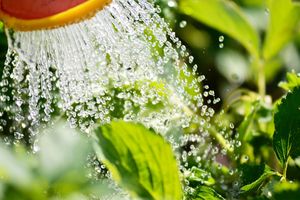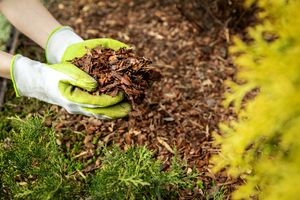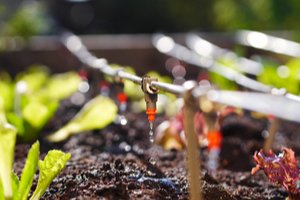Many people look forward all winter to warmer weather and the chance to spend more time outdoors in the garden. There is no doubt that those first days of spring, with everything starting to bloom and the chill in the air subsiding, can be quite magical. However, by the time summer is in full swing, the combination of sweltering heat and long days of sun can really take its toll on us – not to mention our gardens.
Most of us can simply head indoors and turn up the air conditioning when the Northern Virginia summer weather gets the best of us, but our plants have nowhere to hide from the summer heat. However, there are several ways you can ensure your soil stays hydrated this summer and keep your plants from overheating. Here are our best tips.
Water Your Plants Earlier In The Day

One of the best summer gardening tips is to water plants early in the morning while it is still relatively cool outside. This is not just for the comfort of the person doing the watering; it allows water to run down onto the soil and reach the plants’ roots before too much of it can be lost to evaporation as the sun beats down on the soil.
In addition, watering early in the morning means that plants will have water available to them throughout the day, which can help them deal with the sun’s heat better.
Although some people believe that watering plants in the morning makes them vulnerable to scorch, this is a myth. In Northern Virginia, like most areas of the world, the sun does not get intense enough to cause the water droplets to scorch plants. Even if the sun were to reach that intensity, the heat would evaporate the water droplets long before they would be able to focus the sunlight and cause scorching.
If there are days when watering the plants in the morning is not feasible, the next best time for watering is late afternoon or early evening. At this hour, the day’s heat should have mostly passed, yet there will still be enough sun to dry the plants adequately before nightfall. This also cuts down on evaporation and gives the plants a few hours without sun to take water up into their system. However, it is important to get the timing right because if the leaves do not have enough time to dry before nightfall, their dampness could encourage the growth of fungus.
Use Mulch

Mulch can help to protect summer plants from excessive heat and keep their soil hydrated. A thick layer of organic mulch such as wheat, straw, grass clippings, chopped leaves, or pine needles can be added; around two to three inches is ideal. In addition to acting as shade cloth, brown or green mulch layers encourage worms to burrow through the soil, improving its structure and health.
Some people find that they do not need to water their plants as often after mulching with materials such as straw. Alternatively, a low-lying ground cover could help insulate the soil and keep it from drying out. Creeping thyme, for example, can help protect an herb or vegetable garden.
If the plants need additional nutrients, water-soluble fertilizer can be applied on top of the mulch and watered in to reach the roots.
Consider Using Shade Covers
A great way of retaining soil moisture and ensuring summer plants remain hydrated is the use of shade covers. This may come in the form of a large umbrella, old bed sheets, or cardboard. Whatever you use as a shade cover, make sure you keep it a few inches above the plants.
Shade cloth can be used for perennials, fruit trees, shrubs, annuals and vegetables to reduce the heat zone and protect the plants from getting sunburned. A shade cloth also helps plants retain more water by keeping the sun from beating down on the soil and drying it out. In some cases, shade cloth may come with the added benefit of protecting the garden against birds or insects.
Water Plants Deeply
In the summertime, deeper but less-frequent waterings are often more effective than frequent yet shallow waterings. This approach means that the roots of the plant will grow stronger and healthier while cutting down on some of the work involved in gardening.
To determine whether it is necessary to water the plants, push a finger down into the soil. If the soil still feels moist at the depth of your knuckle, it is not time to water. If it is dry, however, a long and deep soak that allows the water to reach the root zone is needed.
Mix Materials That Absorb Water Into The Soil
In summer, it is often helpful to mix organic material that can absorb water into the soil, such as peat moss, compost, or coconut coir. This can help to retain moisture so it will be available to plants during dry spells. In addition, organic material can improve the aeration, health, and structure of the soil, all of which can lead to a more successful garden overall.
Consider Setting Up Drip Irrigation

Watering with significant volumes of water often results in the water running off of the soil’s surface instead of being absorbed down into the lower layers. This is why watering slowly is ideal as it allows the moisture to soak into the soil and make its way to the roots of the plants.
However, drip lines can be purchased at gardening centers to facilitate slow and effective irrigation. They are particularly useful for plants that suffer from leaf diseases and need their leaves to be kept dry.
Get In Touch With Dirt Connections
Finding the right formula for gardening success is not always easy. At Dirt Connections, we can help with gardening projects of all sizes in Northern Virginia. Get in touch today to discuss your project with a soil expert or schedule your delivery of high-quality soil.
Summary

Dirt Connections was started with one goal in mind: providing quality residential and commercial construction services to clients on time and on budget. Reach out for more information on how we can support your next project.
For your convenience our estimates are free and by appointment. Call 703-940-9949 for a free estimate today!









































